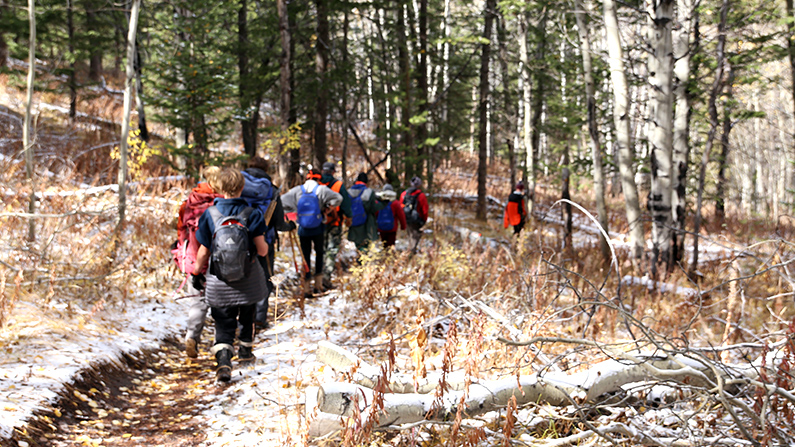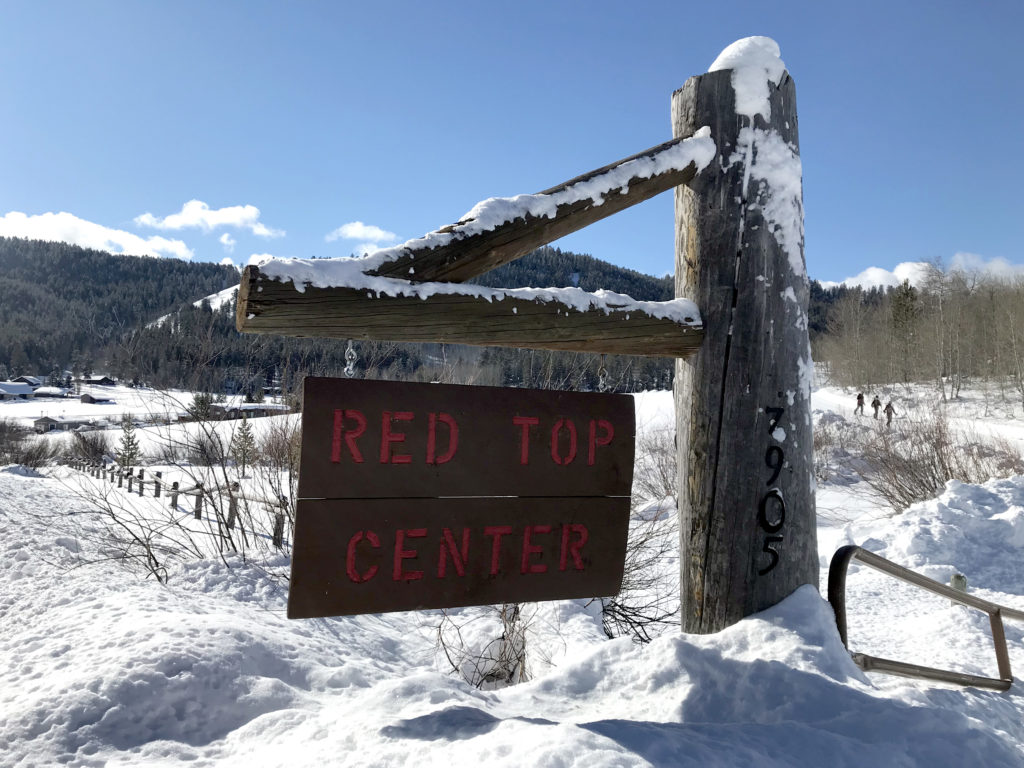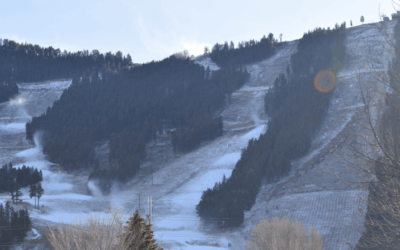KHOL and Stio recently launched a new limited-run podcast series called “Facets: Voices of the Mountain Life.” In five episodes, Facets explores the passions, tensions and healing that people find while living in a mountain town. The third episode, “Healing Outdoors,” debuted on Friday, April 29, and the final two episodes will be published every other Friday through the end of May.
KHOL News Director Kyle Mackie reported and produced the third episode on the residential treatment center Red Top Meadows run by Teton Youth and Family Services. Listen above to hear Mackie discuss her reporting and the making of the episode with KHOL Music and Community Affairs Director Jack Catlin.
The following interview transcript has been edited for clarity and brevity.
JACK CATLIN: So, Kyle, can you tell me about Red Top Meadows and how you first got involved with this story?
KYLE MACKIE: Red Top Meadows is a residential treatment center for Wyoming boys aged 12 to 17 who have either gotten into trouble with the law or are having trouble at their home school district and their school district can no longer serve them for a variety of reasons. And so, Red Top is a place where the boys are often court-ordered to be there, or there are sometimes voluntary placements, or again, it can be a placement through a school district, but it’s a treatment center and it’s also a school. It’s an accredited school. The average length of stay is about a year for these boys who come again from across Wyoming. It’s a campus that’s very rustic, it’s out on Fall Creek Road, kind of in between Wilson and Hoback and down past the Munger Mountain Trail system, if folks are familiar.
And so the boys are living there on-site, going to school. And what’s unique about Red Top in the State of Wyoming is that they are using wilderness therapy experiences. So, there are four big wilderness trips throughout the year. And in Red Top language they call them ‘wildys.’ This all started–I found out about this at a taco party at my old house in Victor last winter. Somebody was there who works at Red Top. And I met a couple of people who work there as childcare staffers, that’s kind of like your entry-level position there. That takes a really dedicated staff member to be out there. The shifts are long. Often you’re staying overnight and kind of living there with them for various shifts. And I just thought when I heard about this program, like, ‘Wow, how cool. I’m hearing about this for the first time. I think other folks might be, too.’ And it was kind of a dream to do a story [about it]. So, when we came up with the idea for Facets, I knew right away I really wanted to do an episode on Red Top.
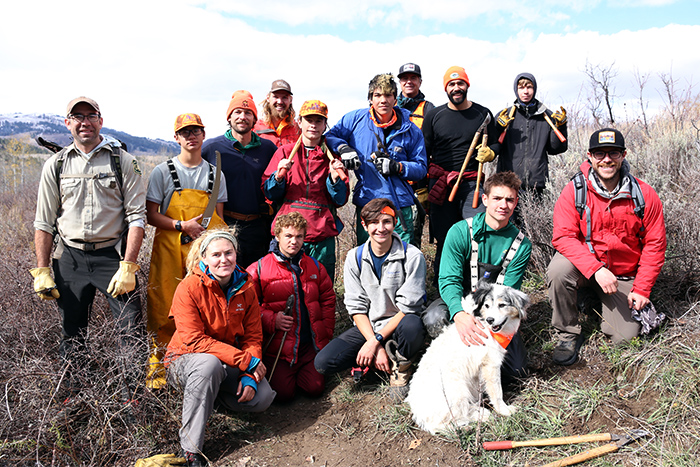
Red Top Meadows students and staff members pose with the Bridger-Teton National Forest Jackson Ranger District’s Trails and Wilderness Supervisor Tim Farris (far left) during a trail maintenance project in October 2021. (Kyle Mackie/KHOL)
CATLIN: What exactly is wilderness therapy? And can you tell us a little bit about why it works?
MACKIE: Yeah, that was for me one of the funnest parts I think of doing this is kind of learning about how wilderness therapy works. I go back a lot to something that my mom always told me growing up. My parents are super active. My mom’s always been a runner, and I remember her saying, ‘Running is my therapy.’ And that’s something that I sort of internalized and became true for me. I didn’t really know why. I kind of approached this episode knowing like, ‘I know I feel better outside,’ and I think a lot of us feel that way here in Jackson and in the Tetons. But like, why? Why is that?
So, I am not a therapist or scientist myself, but what I have learned from one of the clinicians out at Red Top and talking with other staff is that being outside and sort of feeling this connection to the natural world and something outside of ourselves and even bigger than ourselves, especially when that’s coupled with some kind of movement, can really help us re-regulate our nervous systems and get us out of this fight or flight state that we’re constantly in. And that can also really help rewire somebody’s brain who is overcoming trauma. You can really be perpetually in this flight or fight state. And so, movement outside, a kind of, like, regular movement, helps kind of reset your brain. And that’s part of what they’re teaching students at Red Top. Most of the students are overcoming some kind of relational trauma that was inflicted either intentionally or unintentionally by their primary caregivers.
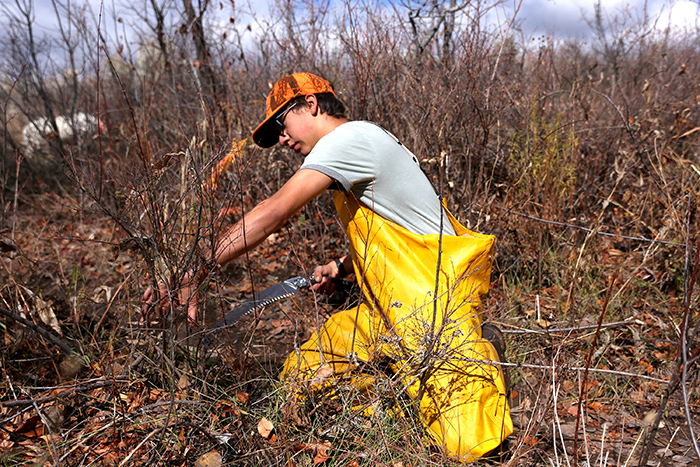
Red Top students have helped build and maintain much of the Munger Mountain trail system since the program was established in 1982. (Kyle Mackie/KHOL)
CATLIN: So, what can you tell me about some of the students you met at Red Top?
MACKIE: Yeah, I should say that I’m super grateful to all of them there. It’s a pretty small crew. Red Top can accommodate up to 14 students at a time but while I was reporting this, they had like nine or 10 over the course of the few months that I was kind of following the group. I’m super, super grateful that they were cool with having me around with a microphone and joining them on some hikes and skiing and in school. So, thank you to all of them there.
A couple of the students who sort of ended up becoming featured in the podcast episode are Connor, Gavin, Hunter and Sam. We are only using first names in this episode also to protect the boys’ privacy. They’re minors. A lot of them are really open about the challenges that they’ve faced. Many of them have been in other–I’m not sure if detention center is the right word–but they’ve been in the juvenile justice system and they’ve been at other places like the Wyoming Boys School, which is more of a locked facility. They really expressed gratitude for being at Red Top, frankly. It’s a lovely campus. You’re really living out up against National Forest Land. It’s not a locked facility. Your bedroom’s not locked at night. I think they find it to be a really supportive atmosphere and they are also just goofy. Like, I talk about how in the episode I was a little nervous going into this project. I knew that some of these kids are juvenile offenders and [I wondered whether] these teenage boys [were] going to be kind of scary to me. And that just melted away. I felt embarrassed by feeling that way once I got there and met them. They’re frankly a really sweet bunch of kids, super goofy, messing around and like singing Nirvana out on the trail and picking up bones that they find and assembling these kind of like elk totem bone structures at their camp to be like the guardians of the camp. It was like any group of teenagers you’d find.

A statue made of found elk bones overlooks the boys’ camp during the fall wildy in October 2021. (Kyle Mackie/KHOL)
CATLIN: It seems like a focus of Red Top is building a sense of community. How do they incorporate that into the program?
MACKIE: From what I observed and what I heard from staff members at Red Top, building healthy relationships is really like the cornerstone of the program because these kids have been harmed by people in their lives and some of the people closest to them. And so they really need to be able to learn how to trust again. Trust authority figures, trust adults. And they’re also building, you know, strong relationships among themselves, like among the other boys there. And many of them talk to me about how they are supporting one another in their journeys and also building relationships with these adults who they can look up to and trust.
You mentioned community, and how important it is to give back to a community. I think that’s something they focus on at Red Top because these are students who maybe in the past have harmed communities they were part of or taken away from communities. So, they’re now focusing on a narrative of like, ‘How can we give back?’ So, one of the experiences that I went and did some reporting [on was] the fall trail maintenance project that they do. That’s the fall wildy in partnership with the Bridger-Teton National Forest. And they’re out there doing trail maintenance. And that’s an opportunity for them to interact with all of the users who are out there, you know, on bikes or trail running or what have you.
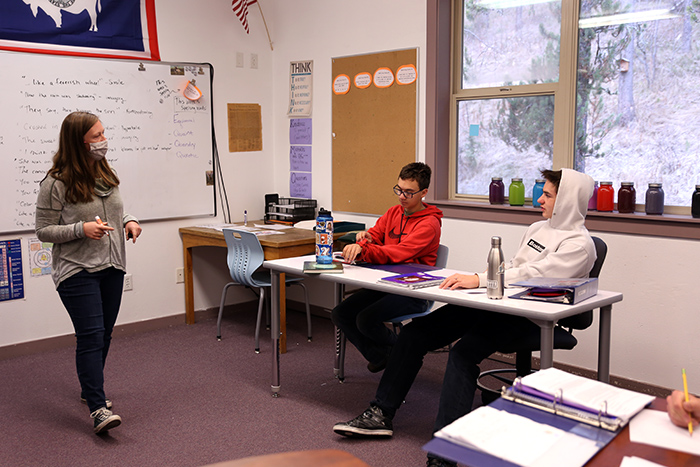
Siri Berg-Moberg teaches language arts at Red Top Meadows, where students generally catch up an average of two grade levels during their stay, according to Teton Youth and Family Services. (Kyle Mackie/KHOL)
CATLIN: Yeah. And one of the things you mentioned in the episode was how they’re teaching kids how to do all these things that make the area that we live in so great, and at the same time teaching them valuable life lessons about community, etc. Can you just expand on that a little more?
MACKIE: Yeah, for sure. I remember talking to Sarah Cavallaro, who’s the executive director of Teton Youth and Family Services, and also Tom Concannon, he’s the director at Red Top. They both worked there as childcare staffers in their early 20s, when they first moved to Jackson. And that’s kind of a common story, I think, for a lot of staffers at Red Top. You have young outdoor enthusiasts who move here to ski or whatever and need work. Maybe hadn’t thought about working with kids before, but this is like a semi-wilderness, you know, therapy experience. So, you know, you’re doing activities with the kids, like mountain biking and backcountry skiing. All the kids learn how to telemark ski at Red Top, which is pretty amazing. And, you know, they teach them how to fly fish.
And then some of the other wildy experiences they do [include] like a 120-mile summer traverse backpacking trip of the entire Teton range. They also do a winter ski trip that’s like five or six nights of winter camping. I don’t remember exactly, but they’re carrying everything they need on their backs and digging snow pits in the winter, camping. I went winter camping for one night this winter in a tent and did not really enjoy myself. So, it’s pretty impressive. And so, I think what Sarah mentioned is that people might kind of like fall into this job of working at this program, but then they realize like, yeah, I’m giving these kids these skills, teaching them these skills of enjoying the outdoors, which we already learned can also be like a therapeutic experience for them, too, and giving them the tools to enjoy the natural world here in the way that all of us who live here came here to do.

All of the students learn how to telemark ski at Red Top. KHOL tagged along for a tour up “Baby Munger Mountain” in January 2022. (Kyle Mackie/KHOL)
CATLIN: So, you get into some of the issues with Wyoming’s juvenile justice system in this episode, like data collection and how funding cuts have impacted Red Top. Can you tell me about that?
MACKIE: That also went into my decision to pursue this story. I think anybody who’s kind of following the news in Wyoming might have heard things like Wyoming has the highest juvenile incarceration rate in the country. That is true according to federal data. What is also true is that Wyoming doesn’t necessarily count the same as other states. That’s an important distinction. Wyoming right now counts students who are in foster care as incarcerated and also students like the ones at Red Top who are in this residential treatment center. They’re counted as incarcerated as well. So, there is some debate on that [statistic].
But it is true that there are lots of data collection issues with the juvenile justice system. There’s not a statewide, uniform reporting system to track what kind of treatments students are going into and which ones are helping. Like, what are the results? Are they helping to actually rehabilitate them? It’s not just me saying this. Actually, the state legislature recognized this as a big issue and it was a big topic during the budget session this past winter in Cheyenne. And actually the governor has now signed a bill that passed through the legislature that is going to require the creation of a uniform statewide reporting system to better track these figures of juvenile justice in Wyoming, because it is recognized that we have a high juvenile incarceration rate and maybe that’s not the best way to be going about this. And at the same time, Wyoming has really high suicide rates as well. It’s often said that our rate is the highest overall–including the adult population, we have the highest suicide rate per capita in the nation. When you separate it out for youth, it’s also up there in like the top five.
CATLIN: Wrapping up here, anything else you want to share with us?
MACKIE: I hope this episode can help spark a conversation about how to better support struggling youth, whether in Wyoming or elsewhere. I also will give a shout-out to Tennessee Watson who has a podcast series called “Cowboy Up” that they did with The Modern West through Wyoming Public Media. It really goes deep into Wyoming’s juvenile justice system if you’d like to learn more on this topic. And then, the other thing we didn’t really talk about is funding cuts but something I learned while reporting this is Red Top for the last several years, they haven’t been full, as I mentioned, like they can have up to 14 students at a time but now they’re below that, around nine, 10. And this does overlap with funding cuts at the state level for mental health and human services organizations, not just Teton Youth and Family Services. But I think any of the human services organizations here in town will tell you that their state funding has been cut dramatically over the past several years. That means that more local funding is having to come from our local government, town and county, and from local philanthropic donors. So, it’s just a change in the reality of funding for programs like this.
CATLIN: You can listen to Facets on Spotify, Apple or wherever you listen to podcasts.

